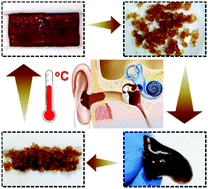Intrinsically recyclable and self-healable conductive supramolecular polymers for customizable electronic sensors†
Abstract
Electronic waste is increasing rapidly and ruining ecosphere owing to the growing amount of unrecyclable and even toxic electronic materials. Sensing components and electronic boards, mainly composed of unrecyclable metal oxides and thermoset polymers, are two major sources of electronic waste. Hence, developing novel electronic materials that can be fully recycled and reused is one of the most investigated concerns for recyclable electronics. In this study, efforts are devoted to inventing an intrinsically recyclable conductive supramolecular polymer, which is composed of a sensing segment of ionic liquid crosslinked by dynamic quadruple hydrogen bonds. This supramolecular polymer exhibits remarkable thermal sensing ability, reprocessability, and recyclability. Based on these advantages, it can be easily molded into an electronic thermometer with controllable size and shape, which can be fully recycled; also, it retains the same thermal sensing performance. Particularly, this supramolecular polymer can be processed into thermal sensing earplugs with customized 3D shapes for ear-temperature measurement as a reliable monitoring approach of body temperature. Thus, it offers great potential for practical applications in special conditions.



 Please wait while we load your content...
Please wait while we load your content...